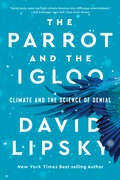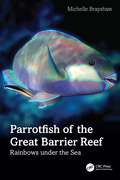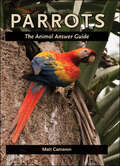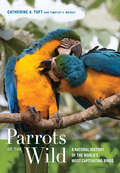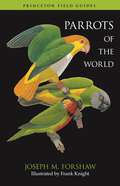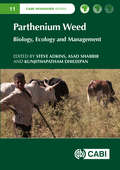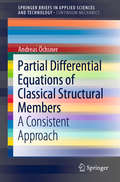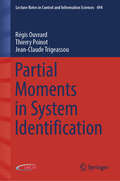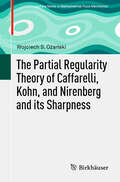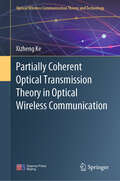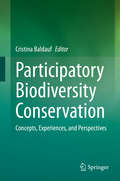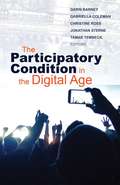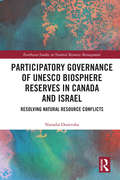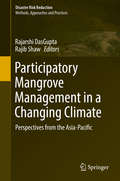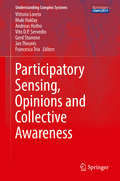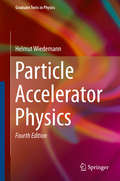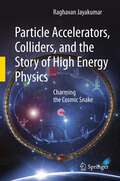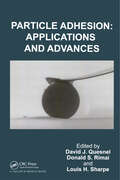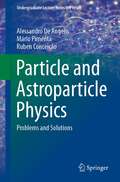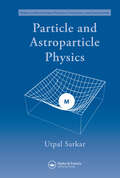- Table View
- List View
The Parrot and the Igloo: Climate And The Science Of Denial
by David LipskyA New York Times Editors’ Choice Named a Best Book of the Year in The New Yorker, Publishers Weekly, Chicago Tribune, and EcoLit Books A USA Today Must-Read Summer Book "David Lipsky spins top-flight climate literature into cliffhanger entertainment." —Zoë Schlanger, New York Times Book Review The New York Times best-selling author explores how “anti-science” became so virulent in American life—through a history of climate denial and its consequences. In 1956, the New York Times prophesied that once global warming really kicked in, we could see parrots in the Antarctic. In 2010, when science deniers had control of the climate story, Senator James Inhofe and his family built an igloo on the Washington Mall and plunked a sign on top: AL GORE'S NEW HOME: HONK IF YOU LOVE CLIMATE CHANGE. In The Parrot and the Igloo, best-selling author David Lipsky tells the astonishing story of how we moved from one extreme (the correct one) to the other. With narrative sweep and a superb eye for character, Lipsky unfolds the dramatic narrative of the long, strange march of climate science. The story begins with a tale of three inventors—Thomas Edison, George Westinghouse, and Nikola Tesla—who made our technological world, not knowing what they had set into motion. Then there are the scientists who sounded the alarm once they identified carbon dioxide as the culprit of our warming planet. And we meet the hucksters, zealots, and crackpots who lied about that science and misled the public in ever more outrageous ways. Lipsky masterfully traces the evolution of climate denial, exposing how it grew out of early efforts to build a network of untruth about products like aspirin and cigarettes. Featuring an indelible cast of heroes and villains, mavericks and swindlers, The Parrot and the Igloo delivers a real-life tragicomedy—one that captures the extraordinary dance of science, money, and the American character.
Parrotfish of the Great Barrier Reef: Rainbows under the Sea
by Michelle BrayshawThe array of colours found on the Scarini tribe (family: Labridae), commonly known as the Parrotfish, is truly astounding and is showcased to breathtaking effect in this book. Photographer and artist Michelle Brayshaw reveals the array of colour changes which these fish display through ontological (slow) and physiological (fast) processes. The obvious differences occur in the three phases of their lives, but it is the subtle changes in colour that can be the most bizarre, occurring while feeding, mating, courting, cleaning, camouflaging themselves to their backgrounds or the fish around them, experiencing mood swings, fighting, playing and, most excitingly of all, when they are transitioning from female to male. This feat is not unique to the Parrotfish, but no other animals do it with such glamour and colour.Through hundreds of hours of observational research, this book highlights the light play and physiological and ontological colour changes of the Scarini found on the Great Barrier Reef in stunning photographic accuracy. It also includes comprehensive information about why Parrotfish are so important for the health and resilience of the reef,f instilling in the reader a deeper sense of the treasures found there and reminding us of the interconnected nature of our existence.
Parrots: The Animal Answer Guide (The Animal Answer Guides: Q&A for the Curious Naturalist)
by Matt CameronGlorious photographs and accurate answers to every question about parrots make this a must-have for any bird lover.Have you ever wondered what parrots eat in the wild? Or why so many species live in the Amazon? How intelligent are parrots? What is the world’s rarest parrot? Parrots: The Animal Answer Guide provides detailed, factual answers to the ninety questions most on our minds. There are more than 350 species of these colorful callers, ranging in size from the diminutive lovebird to the massive macaw. Many species can live to be octogenarians in captivity—sometimes outliving their human caretakers by decades.The beautiful plumage of parrots and the ability to mimic sounds are both a blessing and a curse. A number of species are in danger of extinction because they are captured and sold into the pet trade by unscrupulous dealers. Fortunately, most parrot owners and retailers rely on captive breeding, although an appalling amount of wild collection continues. In addition to discussing parrot behavior and biology, Matt Cameron reveals the truth about the trade in wild parrots and explains what each of us can do to help save native populations. Whether you are a parrot owner, birder, ornithologist, or curious naturalist, you will find that Cameron asks and fully answers every question you have about these incredible birds.
Parrots of the Wild
by Catherine A. Toft Timothy F. WrightParrots of the Wild explores recent scientific discoveries and what they reveal about the lives of wild parrots, which are among the most intelligent and rarest of birds. Catherine A. Toft and Tim Wright discuss the evolutionary history of parrots and how this history affects perceptual and cognitive abilities, diet and foraging patterns, and mating and social behavior. The authors also discuss conservation status and the various ways different populations are adapting to a world that is rapidly changing. The book focuses on general patterns across the 350-odd species of parrots, as well as what can be learned from interesting exceptions to these generalities. A synthetic account of the diversity and ecology of wild parrots, this book distills knowledge from the authors' own research and from their review of more than 2,400 published scientific studies. The book is enhanced by an array of illustrations, including nearly ninety color photos of wild parrots represented in their natural habitats. Parrots of the Wild melds scientific exploration with features directed at the parrot enthusiast to inform and delight a broad audience.
Parrots of the World (Princeton Field Guides #70)
by Joseph M. ForshawThe world’s parrots in one convenient field guideFrom the macaws of South America to the cockatoos of Australia, parrots are among the most beautiful and exotic birds in the world—and among the most endangered. This stunningly illustrated, easy-to-use field guide covers all 356 species and well-differentiated subspecies of parrots, and is the only guide organized by geographical distribution—Australasian, Afro-Asian, and neotropical. It features 146 superb color plates depicting every kind of parrot, as well as detailed, facing-page species accounts that describe key identification features, distribution, subspeciation, habitat, and status. Color distribution maps show ranges of all subspecies, and field identification is further aided by relevant upperside and underside flight images. This premier field guide also shows where to observe each species in the wild, helping make this the most comprehensive and user-friendly guide to the parrots of the world.The only parrot guide to focus on geographical distributionCovers all 356 speciesFeatures 146 color plates depicting all species and well-differentiated subspeciesProvides detailed facing-page species accounts that describe key identification features, distribution, subspeciation, habitat, and statusIncludes color distribution mapsShows where to observe each species in the wild
Parthenium Weed: Biology, Ecology and Management (CABI Invasives Series)
by Stephen Adkins Asad Shabbir Kunjithapatham Dhileepan Muhammad H Ali Sally Allan Ali Ahsan Bajwa Amalia Belgeri Shane Campbell Nimal Chandrasena Michael Day Naeem Khan Ian A Macdonald Alec McClay Andrew McConnachie Rachel McFadyen Adusumilli Narayana Rao Boyang Shi Bharat B. Shrestha Lorraine Strathie Sushil Kumar Tamado Tana Saichun Tang Colette Terblanche Nguyen Thi Thi Wayne D. Vogler Arne WittThis book explores the most important aspects of the biology, ecology and management of what is one of the world's worst weeds. Originally regarded as a major weed in Australia and India, Parthenium weed is now widespread in around 48 countries in Africa, Asia and the South Pacific, and has the potential to spread to new countries in Africa, Asia and Europe. This book, which is a collective effort by 27 members of the International Parthenium Weed Network, addresses research and knowledge gaps for different countries. It examines the weed's mode of spread, its impact on agricultural production, its effect on the environment and on human health, and its management using biological control, as well as cultural, physical and chemical approaches. It also considers the coordination of the weed's management, possible uses for Parthenium weed, its present distribution and how this is impacted by climate change. This book includes: A detailed analysis of Parthenium weed biology. Experiences with Parthenium weed worldwide. An explanation of practical management options. This book will be of interest to graduate students and researchers in universities and institutes, in the fields of plant ecology, botany, agriculture, conservation and restoration ecology.
Parthenium Weed: Biology, Ecology and Management (CABI Invasives Series #7)
by Muhammad H Ali Sally Allan Ali Ahsan Bajwa Amalia Belgeri Shane Campbell Nimal Chandrasena Michael Day Naeem Khan Ian A Macdonald Alec McClay Andrew McConnachie Rachel McFadyen Adusumilli Narayana Rao Boyang Shi Bharat B. Shrestha Lorraine Strathie Sushil Kumar Tamado Tana Saichun Tang Colette Terblanche Nguyen Thi Thi Wayne D. Vogler Arne WittThis book explores the most important aspects of the biology, ecology and management of what is one of the world's worst weeds. Originally regarded as a major weed in Australia and India, Parthenium weed is now widespread in around 48 countries in Africa, Asia and the South Pacific, and has the potential to spread to new countries in Africa, Asia and Europe. This book, which is a collective effort by 27 members of the International Parthenium Weed Network, addresses research and knowledge gaps for different countries. It examines the weed's mode of spread, its impact on agricultural production, its effect on the environment and on human health, and its management using biological control, as well as cultural, physical and chemical approaches. It also considers the coordination of the weed's management, possible uses for Parthenium weed, its present distribution and how this is impacted by climate change. This book includes: A detailed analysis of Parthenium weed biology. Experiences with Parthenium weed worldwide. An explanation of practical management options. This book will be of interest to graduate students and researchers in universities and institutes, in the fields of plant ecology, botany, agriculture, conservation and restoration ecology.
Partial Differential Equations of Classical Structural Members: A Consistent Approach (SpringerBriefs in Applied Sciences and Technology)
by Andreas ÖchsnerThe derivation and understanding of Partial Differential Equations relies heavily on the fundamental knowledge of the first years of scientific education, i.e., higher mathematics, physics, materials science, applied mechanics, design, and programming skills. Thus, it is a challenging topic for prospective engineers and scientists. This volume provides a compact overview on the classical Partial Differential Equations of structural members in mechanics. It offers a formal way to uniformly describe these equations. All derivations follow a common approach: the three fundamental equations of continuum mechanics, i.e., the kinematics equation, the constitutive equation, and the equilibrium equation, are combined to construct the partial differential equations.
Partial Moments in System Identification (Lecture Notes in Control and Information Sciences #494)
by Régis Ouvrard Thierry Poinot Jean-Claude TrigeassouThis book provides a complete round-up of developments concerned with the application of partial moments in system identification and data-driven modelling; it captures the essence of work carried out at the Laboratoire d'Informatique et d'Automatique pour les Systèmes for more than 40 years. The book begins with introductory material, describing both the mathematical tools associated with partial moments and reinitialized partial moments and an example demonstrating their use. The authors then proceed to show how these tools can be used for the identification of continuous-time linear models, discrete-time linear models, continuous-time linear state-space models, linear parameter-varying models and multidimensional models based on partial differential equations. The properties and performances of each of these approaches are presented. The analogy with algebraic approaches is proved, thus opening perspectives for extension to other fields. The text removes some long-standing limitations on the implementation of partial-moment-based tools in system identification. This book is of interest to researchers and postgraduates studying system identification, control theory, applied mathematics and computer science. It is also useful for engineers working on industrial applications of the parametric estimation of mathematical models.
Partial Order Concepts in Applied Sciences
by Marco Fattore Rainer BruggemannTThis book illustrates recent advances in applications of partial order theory and Hasse diagram techniques to data analysis, mainly in the socio-economic and environmental sciences. For years, partial order theory has been considered a fundamental branch of mathematics of only theoretical interest. In recent years, its effectiveness as a tool for data analysis is increasingly being realized and many applications of partially ordered sets to real problems in statistics and applied sciences have appeared. Main examples pertain to the analysis of complex and multidimensional systems of ordinal data and to problems of multi-criteria decision making, so relevant in social and environmental sciences. Partial Order Concepts in Applied Sciences presents new theoretical and methodological developments in partial order for data analysis, together with a wide range of applications to different topics: multidimensional poverty, economic development, inequality measurement, ecology and pollution, and biology, to mention a few. The book is of interest for applied mathematicians, statisticians, social scientists, environmental scientists and all those aiming at keeping pace with innovation in this interesting, growing and promising research field.
The Partial Regularity Theory of Caffarelli, Kohn, and Nirenberg and its Sharpness (Advances in Mathematical Fluid Mechanics)
by Wojciech S. OżańskiThis monograph focuses on the partial regularity theorem, as developed by Caffarelli, Kohn, and Nirenberg (CKN), and offers a proof of the upper bound on the Hausdorff dimension of the singular set of weak solutions of the Navier-Stokes inequality, while also providing a clear and insightful presentation of Scheffer’s constructions showing their bound cannot be improved. A short, complete, and self-contained proof of CKN is presented in the second chapter, allowing the remainder of the book to be fully dedicated to a topic of central importance: the sharpness result of Scheffer. Chapters three and four contain a highly readable proof of this result, featuring new improvements as well. Researchers in mathematical fluid mechanics, as well as those working in partial differential equations more generally, will find this monograph invaluable.
Partially Coherent Optical Transmission Theory in Optical Wireless Communication (Optical Wireless Communication Theory and Technology)
by Xizheng KeThis book introduces the theory and research methods of partially coherent optical, points out the significance of this study, analyzes the basic theories involved in partially coherent light, and explains the complete coherence of laser is not a necessary condition for good directivity, and partially spatially coherent optical sources can also produce the same far-field intensity distribution as lasers. This type of beam with good directivity but only partial spatial coherence is called a Gaussian Schell model beam, which can be used as a physical model to describe multimode lasers under certain conditions. This book is applicable to the large number of engineers and technicians involved in wireless optical communication and college teachers. It can also be used as a teaching material for graduate students and senior undergraduates in related fields.
Participatory Biodiversity Conservation: Concepts, Experiences, and Perspectives
by Cristina BaldaufIt has long been claimed that addressing biodiversity loss and other environmental problems demands a better understanding of the social dimensions of conservation; nevertheless, the active participation of indigenous peoples and local communities (IPLCs) in conservation initiatives is still a challenging and somehow controversial issue. In this context, this book hopes to give voice to other perspectives related to biodiversity conservation beyond the “fortress conservation” model and emphasize one of the pillars of democracy – popular participation. It covers a wide range of environments and issues of special significance to the topic, such as the expansion of culturally constructed niches, protected areas and food security, community-based management, participatory agroforestry, productive restoration and biocultural conservation. The contents also explore the limitations and shortcomings of participatory practices in protected areas, the relationship between the global crisis of democracy and the decline of biocultural diversity, as well as present current discussions on policy frameworks and governance systems for effective participatory biodiversity conservation. In sum, this book provides a comprehensive and realistic perspective on the social dimensions of conservation based on a series of interrelated themes in participatory biodiversity conservation. The connections between biocultural conservation and the current political and economic environment are highlighted through the chapters and the book closes with a debate on ways to reconcile human welfare, environmental justice and biodiversity conservation.
The Participatory Condition in the Digital Age (Electronic Mediations #51)
by Darin Barney Gabriella Coleman Christine Ross Jonathan Sterne Tamar TembeckJust what is the &“participatory condition&”? It is the situation in which taking part in something with others has become both environmental and normative. The fact that we have always participated does not mean we have always lived under the participatory condition. What is distinctive about the present is the extent to which the everyday social, economic, cultural, and political activities that comprise simply being in the world have been thematized and organized around the priority of participation. Structured along four axes investigating the relations between participation and politics, surveillance, openness, and aesthetics, The Participatory Condition in the Digital Age comprises fifteen essays that explore the promises, possibilities, and failures of contemporary participatory media practices as related to power, Occupy Wall Street, the Arab Spring uprisings, worker-owned cooperatives for the post-Internet age; paradoxes of participation, media activism, open source projects; participatory civic life; commercial surveillance; contemporary art and design; and education. This book represents the most comprehensive and transdisciplinary endeavor to date to examine the nature, place, and value of participation in the digital age. Just as in 1979, when Jean-François Lyotard proposed that &“the postmodern condition&” was characterized by the questioning of historical grand narratives, The Participatory Condition in the Digital Age investigates how participation has become a central preoccupation of our time. Contributors: Mark Andrejevic, Pomona College; Bart Cammaerts, London School of Economics and Political Science (LSE); Nico Carpentier, Vrije Universiteit Brussel (VUB – Free University of Brussels) and Charles University in Prague; Julie E. Cohen, Georgetown University; Kate Crawford, MIT; Alessandro Delfanti, University of Toronto; Christina Dunbar-Hester, University of Southern California; Rudolf Frieling, California College of Arts and the San Francisco Art Institute; Salvatore Iaconesi, La Sapienza University of Rome and ISIA Design Florence; Jason Edward Lewis, Concordia University; Rafael Lozano-Hemmer; Graham Pullin, University of Dundee; Trebor Scholz, The New School in New York City; Cayley Sorochan, McGill University; Bernard Stiegler, Institute for Research and Innovation in Paris; Krzysztof Wodiczko, Harvard Graduate School of Design; Jillian C. York.
Participatory Governance of UNESCO Biosphere Reserves in Canada and Israel: Resolving Natural Resource Conflicts (Earthscan Studies in Natural Resource Management)
by Natasha DonevskaThis book explores how participatory governance processes help to find integrated solutions to resource-based development while protecting ecosystems in UNESCO designated areas. Participatory Governance of UNESCO Biosphere Reserves in Canada and Israel explores how stakeholders’ participation in decision-making processes related to natural resource management facilitates or hinders the obtainment of an acceptable balance between nature protection and sustainable development policies in the eyes of the participating stakeholders. A comparative analysis of nature versus development conflicts in the Megiddo and Mount Carmel biosphere reserves in Israel and the Mount Arrowsmith and Clayoquot Sound biosphere reserves in Canada, showcases the different approaches in implementing the biosphere reserve concept. The participatory processes of stakeholders, including governments, resource-based industries, local and indigenous communities and environmental NGOs established to address the local natural resource use problems are considered to be an opportunity of reconciliation among stakeholders with diverse interests, lifestyles and cultures but also improving the relationship between man and nature. Yet, achievement of these goals has proven to be a challenge. In some cases the participatory decision-making process yields benefits and in some cases it fails to deliver expected results. This book explores why is that the case. This title will be of great interest to students and scholars of natural resource management, integrated approaches to conservation and sustainable development, and participatory governance of social-ecological systems. It will also be of interest to environmental conflict mediators, participatory process facilitators, policymakers and professionals involved in managing social-ecological systems or establishing biosphere reserves.
Participatory Mangrove Management in a Changing Climate
by Rajarshi Dasgupta Rajib ShawThis book outlines the performance and management of mangroves in the changing climatic scenario of the Asia-Pacific region and draws examples and lessons from the national and community-driven mangrove conservation programs of relevant countries including Pakistan, India, Bangladesh, Sri Lanka, Myanmar, Thailand, Cambodia, Indonesia, the Philippines, and Japan as well as the Pacific islands. By highlighting the major drawbacks that hinder effective mangrove conservation, the book contributes towards enhancing climate resilience of communities through proposition of corrective methods and ameliorative approaches of mangrove conservation. Mangroves play an important role in adapting to climate change and provide a plethora of ecosystem services that are fundamental to human survival. Yet these ecosystems are exceptionally prone to extinction due to increased human interventions and changes in environmental boundary conditions. Especially in the Asia-Pacific region, mangroves have dwindled at an exceptional high rate over the past three decades. As the threat of climate change hovers over millions of people in this region, particularly those who crowd the low-lying coastal areas, conservation/restoration of mangroves through appropriate policies and practices remain highly imperative. The primary target readers for this book are students and researchers in the fields of conservation and management of mangroves, especially from the developing tropical countries of the Asia-Pacific region. Other target groups comprise policy planners, practitioners, and NGO workers, who will be able to apply the collective knowledge from this work towards proactive mangrove conservation through effective mediation in local communities.
Participatory Plant Breeding: Concept and Applications
by Atul Bhargava Shilpi SrivastavaPlant breeding has played a significant role in the development of human civilizations. Conventional plant breeding has significantly improved crop yield by genetically manipulating agronomically important traits. However, it has often been criticized for ignoring indigenous germplasm, failing to address the needs of the marginal and the poor farmers, and emphasizing selection for broad instead of local adaptation. Participatory plant breeding (PPB) is the process by which the producers and other stakeholders are actively involved in a plant-breeding programme, with opportunities to make decisions throughout. The Working Group on Participatory Plant Breeding (PPBwg) was established in 1996 under the framework of the Consultative Group on International Agricultural Research (CGIAR). Research in PPB can promote informed participation and trust in research among consumers and producers, and in recent years, PPB has had a significant impact on food production by quickly and cost-effectively producing improved crop varieties. At the same time, there has been significant research in the area. PPB offers significant advantages that are particularly relevant to developing countries where large investments in plant breeding have not led to increased production, especially in the marginal environments. In addition to the economic benefits, participatory research has a number of psychological, moral, and ethical benefits, which are the consequence of a progressive empowerment of the farming communities. PPB can empower groups such as women or less well-off farmers that are traditionally left out of the development process.This book explores the potential of PPB in the coming decades. The topic is more relevant since international breeding efforts for major crops are aimed at decentralizing local breeding methods to better incorporate the perspective of end users into the varietal development process. The first book incorporating the upcoming research on this novel breeding approach, it reviews the important tools and applications of PPB in an easy-to-read, succinct format, with illustrations to clarify these complex topics. It provides readers with a basic idea of participatory plant breeding as well as advances in the field and insights into the future to facilitate the successful integration of farmers into breeding programmes.This book is a valuable reference resource for agriculturists, agricultural advisers, policy makers, NGOs, post-doctoral students and scientists in agriculture, horticulture, forestry and botany.
Participatory Sensing, Opinions and Collective Awareness
by Francesca Tria Jan Theunis Gerd Stumme Vito D. P. Servedio Andreas Hotho Muki Haklay Vittorio LoretoThis book introduces and reviews recent advances inthe field in a comprehensive and non-technical way by focusing on the potentialof emerging citizen-science and social-computation frameworks, coupled with thelatest theoretical and modeling tools developed by physicists, mathematicians,computer and social scientists to analyse, interpret and visualize complex datasets. There is overwhelming evidence that the currentorganisation of our economies and societies is seriously damaging biologicalecosystems and human living conditions in the short term, with potentiallycatastrophic effects in the long term. The need to re-organise the dailyactivities with the greatest impact - energy consumption, transport, housing -towards a more efficient and sustainable development model has recently beenraised in the public debate on several global, environmental issues. Above all,this requires the mismatch between global, societal and individual needs to beaddressed. Recent advances in Information and Communication Technologies (ICT)can trigger important transitions at the individual and collective level toachieve this aim. Based on the findings of the collaborative researchnetwork EveryAware the following developments among the emerging ICTtechnologies are discussed in depth in this volume: * Participatory sensing - where ICT development ispushed to the level where it can supportinformed action at the hyperlocal scale, providing capabilities forenvironmental monitoring, data aggregation and mining, as well as informationpresentation and sharing. * Web gaming, social computing and internet-mediatedcollaboration - where the Web will continue to acquire the status of aninfrastructure for social computing, allowing users' cognitive abilities to becoordinated in online communities, and steering the collective action towardspredefined goals. * Collective awareness and decision-making - where theaccess to both personal and community data, collected by users, processed withsuitable analysis tools, and re-presented in an appropriate format by usablecommunication interfaces leads to a bottom-up development of collective socialstrategies.
Particle Accelerator Physics
by Helmut WiedemannThis book by Helmut Wiedemann is a well-established, classic text, providing an in-depth and comprehensive introduction to the field of high-energy particle acceleration and beam dynamics. The present 4th edition has been significantly revised, updated and expanded. The newly conceived Part I is an elementary introduction to the subject matter for undergraduate students. Part II gathers the basic tools in preparation of a more advanced treatment, summarizing the essentials of electrostatics and electrodynamics as well as of particle dynamics in electromagnetic fields. Part III is an extensive primer in beam dynamics, followed, in Part IV, by an introduction and description of the main beam parameters and including a new chapter on beam emittance and lattice design. Part V is devoted to the treatment of perturbations in beam dynamics. Part VI then discusses the details of charged particle acceleration. Parts VII and VIII introduce the more advanced topics of coupled beam dynamics and describe very intense beams - a number of additional beam instabilities are introduced and reviewed in this new edition. Part IX is an exhaustive treatment of radiation from accelerated charges and introduces important sources of coherent radiation such as synchrotrons and free-electron lasers. The appendices at the end of the book gather useful mathematical and physical formulae, parameters and units. Solutions to many end-of-chapter problems are given. This textbook is suitable for an intensive two-semester course starting at the senior undergraduate level.
Particle Accelerator Physics: Basic Principles And Linear Beam Dynamics (Graduate Texts in Physics)
by Helmut WiedemannThis book by Helmut Wiedemann is a well-established, classic text, providing an in-depth and comprehensive introduction to the field of high-energy particle acceleration and beam dynamics.The present 4th edition has been significantly revised, updated and expanded. The newly conceived Part I is an elementary introduction to the subject matter for undergraduate students. Part II gathers the basic tools in preparation of a more advanced treatment, summarizing the essentials of electrostatics and electrodynamics as well as of particle dynamics in electromagnetic fields. Part III is an extensive primer in beam dynamics, followed, in Part IV, by an introduction and description of the main beam parameters and including a new chapter on beam emittance and lattice design. Part V is devoted to the treatment of perturbations in beam dynamics. Part VI then discusses the details of charged particle acceleration. Parts VII and VIII introduce the more advanced topics of coupled beam dynamics and describe very intense beams – a number of additional beam instabilities are introduced and reviewed in this new edition. Part IX is an exhaustive treatment of radiation from accelerated charges and introduces important sources of coherent radiation such as synchrotrons and free-electron lasers. The appendices at the end of the book gather useful mathematical and physical formulae, parameters and units. Solutions to many end-of-chapter problems are given.This textbook is suitable for an intensive two-semester course starting at the senior undergraduate level.
Particle Accelerators: From Big Bang Physics to Hadron Therapy
by Ugo AmaldiRather than focusing on the contributions of theoretical physicists to the understanding of the subatomic world and of the beginning of the universe - as most popular science books on particle physics do - this book is different in that, firstly, the main focus is on machine inventors and builders and, secondly, particle accelerators are not only described as discovery tools but also for their contributions to tumour diagnosis and therapy. The characters of well-known (e. g. Ernest Lawrence) and mostly unknown actors (e. g. Nicholas Christofilos) are outlined, including many colourful quotations. The overall picture supports the author's motto: "Physics is beautiful and useful". Advance appraisal: "Accelerators go all the way from the unique and gargantuan Large Hadron Collider to thousands of smaller versions in hospitals and industry. Ugo Amaldi has experience across the range. He has worked at CERN and has for many years been driving the application of accelerators in medicine. This is a must-read introduction to this frontier of modern technology, written beautifully by a world expert. " Frank Close, Professor of Physics at Oxford University author of "The Infinity Puzzle" "This book should be read by school teachers and all those interested in the exploration of the microcosm and its relation to cosmology, and in the use of accelerators for medical applications. With a light hand and without formulae the autho r easily explains complicated matters, spicing up the text with amusing historical anecdotes. His reputation as an outstanding scientist in all the fields treated guarantees high standards. " Herwig Schopper, former CERN Director General author of "LEP - The Lord of the Collider Rings at CERN" "This book tells the story of modern physics with an unusual emphasis on the machine-builders who made it all possible, and their machines. Learning to accelerate particles has enabled physicists to probe the subatomic world and gain a deeper understanding of the cosmos. It has also brought numerous benefits to medicine, from the primitive X-ray machines of over a century ago to today's developments in hadron therapy for cancer. Amaldi tells this story in a most fascinating way. " Edward Witten, Professor of Mathematical Physics at the Institute for Advanced Study in Princeton; Fields Medal (1990)
Particle Accelerators, Colliders, and the Story of High Energy Physics
by Raghavan JayakumarThe Nordic mythological Cosmic Serpent, Ouroboros, is said to be coiled in the depths of the sea, surrounding the Earth with its tail in its mouth. In physics, this snake is a metaphor for the Universe, where the head, symbolizing the largest entity - the Cosmos - is one with the tail, symbolizing the smallest - the fundamental particle. Particle accelerators, colliders and detectors are built by physicists and engineers to uncover the nature of the Universe while discovering its building blocks. "Charming the Cosmic Snake" takes the readers through the science behind these experimental machines: the physics principles that each stage of the development of particle accelerators helped to reveal, and the particles they helped to discover. The book culminates with a description of the Large Hadron Collider, one of the world's largest and most complex machines operating in a 27-km circumference tunnel near Geneva. That collider may prove or disprove many of our basic theories about the nature of matter. The book provides the material honestly without misrepresenting the science for the sake of excitement or glossing over difficult notions. The principles behind each type of accelerator is made accessible to the undergraduate student and even to a lay reader with cartoons, illustrations and metaphors. Simultaneously, the book also caters to different levels of reader's background and provides additional materials for the more interested or diligent reader.
Particle Adhesion: Applications and Advances
by David J. Quesnel Donald S. Rimai Louis H. SharpeWhenever a curved surface interacts with another surface, the principles of adhesion are at work. From the cells in your body to the dust on your glasses, intermolecular forces cause materials to attract one another. Elastic deformations resulting from these adhesive interactions store strain that can be liberated during particle detachment. Time d
Particle and Astroparticle Physics: Problems and Solutions (Undergraduate Lecture Notes in Physics)
by Mário Pimenta Ruben Conceição Alessandro De AngelisThis book presents more than 200 problems, with detailed guided solutions, spanning key areas of particle physics and astrophysics. The selected examples enable students to gain a deeper understanding of these fields and also offer valuable support in the preparation for written examinations. The book is an ideal companion to Introduction to Particle and Astroparticle Physics: Multimessenger Astronomy and its Particle Physics Foundations, written by Alessandro De Angelis and Mário Pimenta and published in its second edition in Springer’s Undergraduate Lecture Notes in Physics series in 2018. It can, however, also be used independently. The present book is organized into 11 chapters that match exactly those in the companion textbook, and each of the exercises is given a title to facilitate identification of the subject within that book. Some new exercises have been added because they are considered helpful on the basis of the experience gained by teachers while using the textbook. Beyond students on relevant courses, exercises and solutions in particle and astroparticle physics are of value for physics teachers and to all who seek aid to self-training.
Particle and Astroparticle Physics
by Utpal SarkarFrom superstring theory to models with extra dimensions to dark matter and dark energy, a range of theoretically stimulating ideas have evolved for physics beyond the standard model. These developments have spawned a new area of physics that centers on the interplay between particle physics and cosmology-astroparticle physics. Providing the necessa
